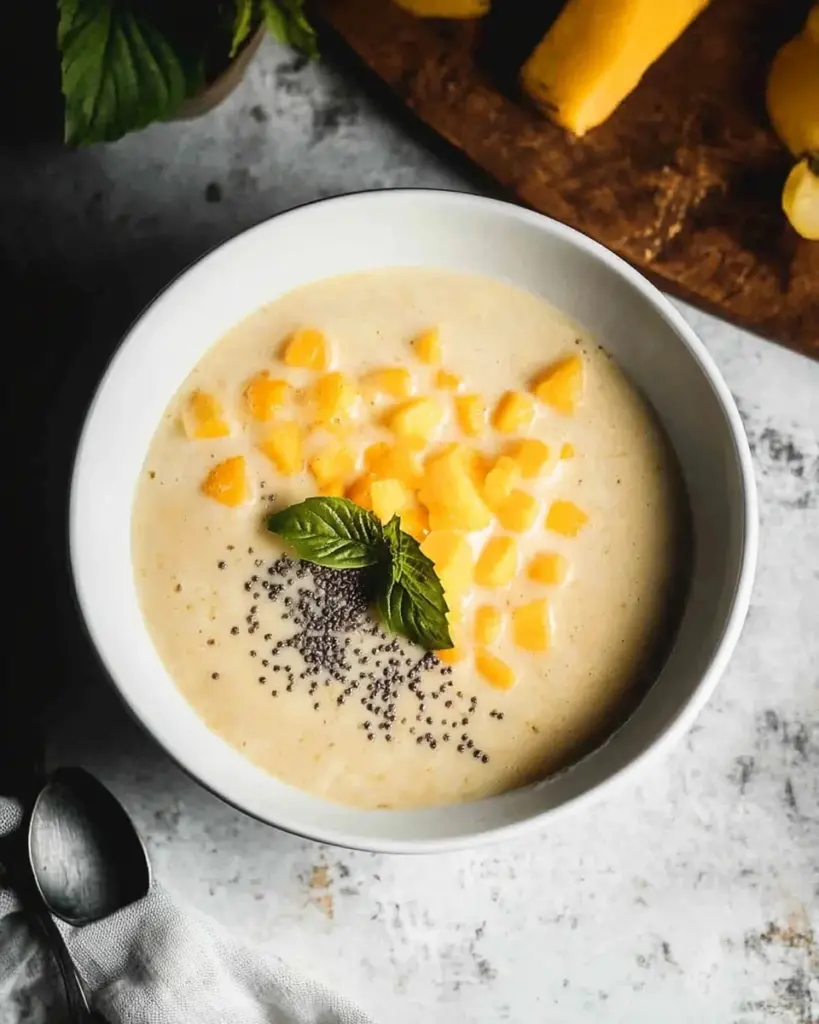A Sweet Memory Wrapped in Mango Bliss
Every summer, the arrival of mango season brought an air of excitement to our home. My mother would carefully select the ripest, juiciest mangoes, their golden skin glowing like tiny suns in the kitchen. She would slice them open, revealing their bright orange flesh, and we would stand around the counter, sneaking little bites before they could make it into our favorite dessert—Mango Sago.
Mango Sago wasn’t just a dessert; it was a ritual, a celebration of the season’s sweetest fruit. The creamy coconut milk, the chewy pearls of sago, and the fragrant mango puree all came together in perfect harmony. It was the taste of childhood summers, of laughter and shared moments.
Now, every time I prepare a bowl of Mango Sago, I am transported back to those warm afternoons, my hands sticky with mango juice, eagerly waiting for the dessert to chill before I could take my first spoonful. Whether you’re discovering this dessert for the first time or looking to recreate a nostalgic favorite, Mango Sago is a simple yet exquisite treat that will bring a touch of tropical joy to any occasion.
Why Mango Sago is a Must-Try Dessert
1. A Perfect Balance of Creaminess and Freshness
Mango Sago combines the smooth, creamy texture of coconut milk with the refreshing taste of ripe mangoes. The addition of chewy sago pearls gives it a delightful contrast, making each bite a mix of rich and light flavors.
2. Naturally Sweet and Refreshing
Unlike overly sugary desserts, Mango Sago relies on the natural sweetness of mangoes, making it a healthier option without sacrificing indulgence. It’s the perfect way to cool down on a hot day.
3. Easy to Make, Yet Elegant to Serve
This dessert requires minimal ingredients and effort, yet it looks and tastes luxurious. Serve it in a glass for a sophisticated presentation or in a simple bowl for a comforting homemade feel.
4. A Crowd-Pleasing Dessert
Whether you’re making it for a family dinner, a summer gathering, or a festive occasion, Mango Sago is guaranteed to impress. It’s naturally dairy-free and gluten-free, making it a great option for guests with dietary restrictions.
Tropical Delight: Creamy Mango Sago Dessert
Ingredients:
- Main Components:
- 1/2 cup mini white tapioca pearls (sago)
- 2 ripe yellow mangoes, peeled and diced
- 1 cup coconut milk
- 1/4 cup sweetened condensed milk
- Fresh mint leaves for garnish (optional)
Directions:
- Cook the Sago Pearls:
- Bring a pot of water to a boil.
- Add the sago pearls and cook until they become translucent, stirring occasionally.
- Once cooked, drain and rinse under cold water to remove excess starch.
- Prepare the Mango Puree:
- In a blender, combine half of the diced mangoes with coconut milk and sweetened condensed milk.
- Blend until smooth and creamy.
- Combine Ingredients:
- In a large bowl, mix the cooked sago pearls with the mango puree.
- Stir in the remaining diced mangoes.
- Chill and Serve:
- Refrigerate the mixture for at least an hour to allow flavors to meld and to serve it cold.
- Before serving, garnish with fresh mint leaves if desired.
Nutritional Information (per serving):
- Calories: 256
- Protein: 2.5g
- Carbohydrates: 46g
- Sugars: 24g
- Fat: 8.6g
- Saturated Fat: 7.5g
- Cholesterol: 0mg
- Sodium: 15mg
Note: Nutritional values are approximate and may vary based on specific ingredients used.

The Origins of Mango Sago
Mango Sago originated in Hong Kong in the 1980s as a creation of fusion dessert shops that combined traditional Asian ingredients with Western-style presentation. The dessert quickly gained popularity across Southeast Asia, with variations appearing in China, Singapore, Malaysia, and the Philippines.
Today, Mango Sago is a staple in many Asian dessert shops and is widely enjoyed at home, thanks to its simple preparation and universally appealing flavors. Over time, it has evolved into different versions, incorporating ingredients like evaporated milk, condensed milk, and even pomelo for an extra citrusy twist.
Creative Variations to Try
While the classic version is already delightful, you can experiment with different flavors and textures to suit your personal taste. Here are a few ways to give Mango Sago an exciting twist:
1. Coconut Mango Sago
For an even richer tropical flavor, use coconut cream instead of coconut milk. The result is a thicker, more luxurious texture that pairs beautifully with the sweet mango.
2. Mango Pomelo Sago
A popular variation from Hong Kong, this version adds pomelo, a citrus fruit similar to grapefruit. The slight tartness of pomelo balances the sweetness of the mango and adds a refreshing bite.
3. Dairy-Free Mango Sago
Skip the condensed milk and replace it with almond milk or oat milk for a completely dairy-free alternative. This makes the dessert even lighter while keeping its signature creamy texture.
4. Chilled Mango Sago with Ice Cream
For a more indulgent treat, serve Mango Sago with a scoop of vanilla or mango ice cream on top. The contrast between the chilled dessert and the melting ice cream makes it a decadent experience.
5. Spiced Mango Sago
Enhance the tropical flavor by adding a pinch of cinnamon or cardamom. These warm spices complement the mango’s natural sweetness and add depth to the dessert.
Frequently Asked Questions
1. What is sago, and where can I buy it?
Sago is a type of starch extracted from tropical palm stems. It looks similar to tapioca pearls but is slightly smaller and chewier. You can find it in most Asian grocery stores, health food stores, or online.
2. Can I use tapioca pearls instead of sago?
Yes, tapioca pearls work as a substitute for sago. However, they have a slightly different texture—tapioca pearls tend to be softer, while sago has a bit more chewiness.
3. How long does it take to cook sago?
Cooking time depends on the type of sago used. Most mini sago pearls cook within 10-15 minutes, while larger pearls may take up to 30 minutes. It’s essential to stir while cooking to prevent sticking.
4. Can I prepare Mango Sago in advance?
Yes! Mango Sago tastes even better when chilled, so you can make it a few hours ahead of time. However, it’s best consumed within 24 hours to keep the mango fresh.
Advertisement
5. Can I freeze Mango Sago?
It’s not recommended to freeze Mango Sago, as the texture of the sago pearls and mango may become watery upon thawing. It’s best enjoyed fresh or after a few hours in the refrigerator.
6. What type of mango is best for this dessert?
The best mangoes for Mango Sago are naturally sweet and fragrant varieties such as Alphonso, Ataulfo, or Carabao mangoes. These mangoes have a rich flavor and smooth texture that blends well into the dessert.
Conclusion: A Taste of Summer in Every Spoonful
Mango Sago is more than just a dessert—it’s a tropical escape, a celebration of the season’s best fruit, and a nostalgic treat that brings people together. Whether you’re making it to relive childhood memories or simply to enjoy a refreshing and creamy dessert, this recipe is sure to become a favorite in your kitchen.
With its simple ingredients, effortless preparation, and endless variations, Mango Sago is a dessert that proves that sometimes, the best things in life are the simplest. So the next time you have ripe mangoes on hand, take a moment to create this delightful dish and savor the flavors of sunshine in a bowl.






